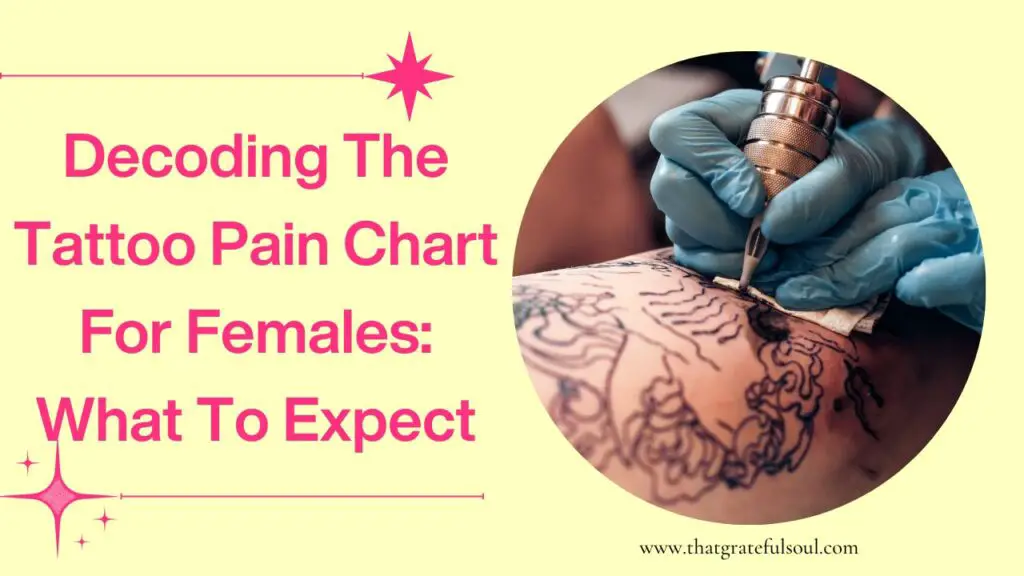Getting a tattoo requires not only creativity but also consideration of the pain factor. The Tattoo
Pain Chart serves as a guidepost, assisting individuals in anticipating the level of discomfort associated with various body parts.

-
Save
Table of Contents
A. Understanding the Tattoo Pain Scale and its Significance
It is critical to understand the Tattoo Pain Scale. It ranges from less painful areas, such as the forearm, to more sensitive areas, such as the ribcage.
B. Factors Influencing Tattoo Pain Perception Among Females
Pain tolerance and design complexity are two factors that influence pain perception in females.
C. Importance of Knowing the Pain Levels to Make Informed Decisions
Being aware of these factors before getting inked is critical for making Informed Decisions and having a more satisfying tattoo experience.
The Tattoo Pain Scale: Breaking It Down
Understanding how different body parts fare in terms of discomfort is necessary for navigating the Tattoo Pain Scale.
A. Exploring Different Parts of the Body on the Pain Scale
Exploring Body Parts reveals interesting differences. Less fleshy areas, such as the wrist, are generally less painful, whereas bony areas, such as the ankle, can be more painful.
B. Perception of Pain Variability Among Individuals
Each person’s perception of pain variability is unique, influenced by factors such as pain tolerance and adrenaline.
C. Common Comparisons: Does Getting a Tattoo Hurt Like…?
Common questions concern the comparison of tattoo pain to other sensations, such as whether
It is comparable to a sunburn or a cat scratch. The Tattoo Pain Scale reveals a multifaceted journey, blending anticipation and curiosity into the tattoo experience.
Factors Influencing Tattoo Pain for Women
The perception of tattoo pain is intricately linked to several female-specific factors.
A. Body Composition: Role of Muscle and Fat in Pain Perception
Body Composition is important, as muscle provides more cushioning than fat.
B. Skin Sensitivity: How Different Skin Types Experience Pain
Different Skin Sensitivity among different skin types contributes to a wide range of pain experiences.
C. Menstrual Cycle and Hormones: Impact on Pain Threshold
The Menstrual Cycle and Hormones are fascinating influencers; pain tolerance may vary throughout the cycle. Hormones can influence sensitivity, making tattoos more or less painful.
Recognizing these factors gives women a better understanding of their pain tolerance, resulting in a more informed and comfortable tattooing experience.
High Pain Areas: What to Expect
Certain tattoo placements are notorious for causing excruciating pain.
A. Spine and Vertebrae Tattoos: Navigating the Bony Regions
Spine and Vertebrae Tattoos necessitate navigating bony regions, which frequently results in sharper sensations.
B. Rib Cage Tattoos: Dealing with Sensitive and Less Padded Areas
Rib Cage Tattoos are especially sensitive due to the lack of padding. Tattooing near the ribs may increase discomfort.
C. Wrist and Ankle Tattoos: Exploring Areas with Thin Skin
Because of the thin skin in these areas, tattooing the wrist and ankles is difficult. These areas are more sensitive to pain.
Moderate Pain Areas: What You Need to Know
Managing tattoo pain is critical for a pleasant experience.
A. Arm and Shoulder Tattoos: Balancing Skin Thickness and Muscles
Tattoos on the arms and shoulders strike a balance between skin thickness and muscle, resulting in manageable pain.
B. Thigh Tattoos: Understanding Pain Variations on Upper and Lower Thighs
Thigh tattoos have pain perception differences between upper and lower areas due to muscle and fat distribution.
C. Foot Tattoos: Tackling Delicate Skin and Bones
Foot Tattoos present special challenges due to their delicate skin and bones. Although pain is subjective, understanding these pain zones can help you make more informed decisions.
Lower Pain Areas: Finding Relief
Finding lower pain areas on the tattoo pain chart can make your tattoo experience more enjoyable.
A. Upper Back Tattoos: Muscular Support and Lesser Pain
Upper Back Tattoos (A) benefit from muscular support, which reduces pain.
B. Buttocks and Hip Tattoos: Padded Areas with Lower Pain Intensity
Buttocks and Hip Tattoos are popular because they provide padded areas with lower pain intensity.
C. Calf Tattoos: Mix of Muscle and Fat Yielding Moderate Pain
Calf Tattoos strike a balance between muscle and fat, resulting in a moderate level of pain.
Understanding pain variations across the body enables people to make well-informed tattoo decisions.
Remember that pain tolerance varies, so selecting a location that corresponds to your level of comfort can improve the overall tattoo experience.
Pain Management Techniques during Tattooing
Starting a tattoo journey does not imply putting yourself through unnecessary pain.
A. Breathing Exercises and Mindfulness: Enhancing Pain Tolerance
Breathing exercises and mindfulness can help you cope with pain by keeping you focused and calm.
B. Numbing Creams and Topical Anesthetics
Temporary Relief Options Topical Anaesthetics and numbing creams provide temporary relief, reducing discomfort during the procedure.
C. Diversion Tactics: Engaging Your Mind During the Tattooing Process
Pain can also be managed by using Diversion Tactics, such as engaging your mind with conversations or music. Exploring these techniques gives you the ability to make your tattoo experience as pleasant as possible.
Remember that pain perception is subjective, so figuring out what works best for you is essential for confidently embracing body art.
Tattoo Pain Over Time: During and After
Tattoo pain is a dynamic experience that changes over time.
A. Initial Pain during Tattooing: What to Expect
The initial pain experienced during tattooing varies according to body location and individual pain threshold. Expect a variety of sensations, ranging from stinging to scratching.
You May Also Like – TATTOO FOR WOMEN CHEST: EXPLORING ELEGANCE AND EXPRESSION
B. Post-Tattoo Pain and Sensation
Navigating the Healing Process Post-Tattoo Pain and Sensation kicks in as part of the healing process after the ink has settled.
The affected area may feel sore, sensitive, or itchy. Following aftercare instructions is critical for minimising pain and promoting proper healing.
Real Stories from Women: Navigating Tattoo Pain
Every woman’s tattoo pain journey is distinct, shaped by her own experiences.
A. Personal Accounts of Women's Tattoo Pain Experiences
Personal Accounts of Women’s Tattoo Pain Experiences reveal a wide range of emotions, from manageable discomfort to surprise. These stories frequently emphasise the significance of location and mindset.
B. How Pain Perception Influenced Their Tattoo Choices
How Pain Perception Affects Their Tattoo Choices demonstrates how some people prefer intricate designs on less painful areas, whereas others embrace pain for the sake of meaningful art.
These women’s stories add depth to the canvas of tattoo experiences by providing insights into the intimate relationship between pain, art, and self-expression.
Tattoo Aftercare and Pain Management
The ink may be dry, but the care is not.
A. Aftercare Tips for Reducing Discomfort and Irritation
Aftercare Tips for Reducing Discomfort and Irritation are the foundation of a quick recovery. Cleaning, moisturising, and avoiding certain activities can all help to reduce pain and promote healing.
B. Managing Post-Tattoo Pain: Dos and Don'ts
Managing Post-Tattoo Pain: Dprovideon’ts guides how to strike the right balance between allowing the tattoo to breathe and protecting it from infections. Listening to your body, using gentle products, and staying hydrated is critical.
Mastering the art of aftercare ensures vibrant tattoos and assists in managing any residual pain, making the ink adventure worthwhile.
Addressing Common Questions about Tattoo Pain for Female
Exploring the world of ink frequently raises concerns about pain.
A. Common Myths and Misconceptions about Tattoo Pain
Tattoo Pain Myths and Misconceptions can cloud perceptions. Using facts to debunk myths like “Tattoos are excruciating” empowers decision-making.
B. Clarifying Concerns and Offering Reassurance
Clarifying Concerns and Offering Reassurance clarifies what to truly expect. Sharing experiences and expert insights can help to alleviate concerns.
Remember that each person’s pain journey is unique. Knowledge, preparation, and an understanding of the nuances can transform the process from tense empowering.
It’s all about stepping confidently into the world of tattoos and making it a beautiful and meaningful experience.
Conclusion: Empowerment and the Tattoo Pain Journey
A tattoo journey entails more than just ink; it’s a journey of self-discovery and empowerment.
Decisions and Embrace the Process Encouragement to Make Informed Decisions and Embrace the Process recognizes the tenacity of people who choose to tell their stories through tattoos. It’s a blank canvas for personal power and creativity.
So, whether you have high or low pain tolerance, remember that the ink you unravel is your unique badge of courage and expression.
-
Save

